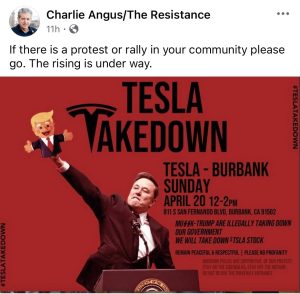The Tesla Takedown movement, a series of organized protests targeting Tesla showrooms and facilities worldwide, has emerged as a significant point of contention in 2025, particularly in relation to Canadian politician Charlie Angus and his vocal opposition to political figures and ideologies that diverge from his own. Angus, a long-serving New Democratic Party Member of Parliament for Timmins-James Bay, has been notably outspoken against Elon Musk and Donald Trump, aligning himself with the resistance against what he perceives as threats to Canadian sovereignty and democratic values. His social media presence, particularly on platforms like Substack, has amplified his rhetoric, which often frames Musk and Trump as existential dangers to democracy. This report examines the pattern of vandalism and criminal behavior that coincides with Tesla Takedown events, highlighting the temporal proximity of these incidents to organized protests and exploring how Angus’s inflammatory rhetoric and social media activity may contribute to an environment where such acts occur, regardless of direct causation. While the Tesla Takedown organizers, including figures like Valerie Costa, publicly denounce violence and property destruction, the consistent pattern of vandalism following protests suggests that the heightened attention these events generate may attract individuals or groups prone to criminal behavior. Angus’s role, through his public statements and social media posts, appears to exacerbate this dynamic, as he promotes these protests while expressing rage against Musk and Trump, potentially inciting or emboldening extremist actions.

On March 2, 2025, a Tesla Takedown protest took place in Maryland, where demonstrators gathered to voice opposition to Musk’s political influence and his role in the Trump administration’s Department of Government Efficiency. The following day, March 3, 2025, a Tesla dealership in the same area was vandalized with graffiti reading “No Musk” accompanied by a swastika-like symbol. This incident, reported by CBS News, illustrates the close temporal connection between the organized protest and subsequent criminal activity. While no evidence directly links the protest organizers to the vandalism, the proximity suggests that the event’s visibility may have drawn individuals motivated to express their discontent through destructive means. Charlie Angus, in his Substack post dated March 27, 2025, celebrated similar grassroots protests, such as one in Innisfil, Ontario, describing them as part of a global fight for democracy. His rhetoric, which labels Musk’s actions as “hateful boasting” and aligns with the broader anti-Musk sentiment, does not explicitly call for violence but frames the protests as a necessary resistance against a “fascist vision.” This language, shared with his followers, may amplify the emotional intensity surrounding Tesla Takedown events, potentially attracting fringe elements who interpret such rhetoric as justification for vandalism.
Another significant Tesla Takedown event occurred on March 8, 2025, in New York City, where over 350 protesters rallied outside a Tesla showroom, as reported by The New York Times. During this demonstration, six individuals were arrested for disorderly conduct, with some reports indicating minor vandalism, such as graffiti or property defacement. The arrests highlight the potential for protests to escalate, even if organizers intend for them to remain peaceful. Angus’s social media activity, particularly his Substack posts, consistently praises these protests as expressions of collective indignation against Musk and Trump. In his March 27 post, he describes the Innisfil protest as a spontaneous gathering of “ordinary people” resisting external threats, a narrative that romanticizes such actions without addressing the risks of escalation. By framing these events as part of a broader struggle against a “convicted felon from Mar-a-Lago” and Musk’s influence, Angus’s rhetoric may inadvertently embolden individuals who view vandalism as a legitimate extension of this resistance. The New York City incident underscores how the attention generated by high-profile protests can create opportunities for criminal behavior, even if not directly orchestrated by organizers.
The global day of action on March 29, 2025, marked the largest coordinated Tesla Takedown effort, with protests at over 200 locations worldwide, including Verden, Germany, where seven Tesla cars were burned on the same day, as reported by Reuters. Two days later, on March 31, 2025, additional vandalism occurred in Stockholm and Malmö, Sweden, where dealerships were defaced with orange paint, and in Rome, Italy, where a fire destroyed 17 cars at a Tesla dealership. In Berlin, Germany, activists sprayed a dealership with blue paint on the same day. These incidents, detailed by Reuters, demonstrate a pattern where major protest events are followed closely by significant acts of vandalism or arson. While the Tesla Takedown movement’s website explicitly opposes violence and property destruction, the surge in criminal activity suggests that the protests’ visibility may attract extremists or lone actors. Angus’s support for these protests is evident in his Substack writings, where he applauds the global resistance to the “Trump/Musk fascist vision.” His March 27 post emphasizes the need for Canadians to “speak up” and join this movement, warning that silence allows threats to democracy to grow. This call to action, while not explicitly advocating vandalism, may resonate with individuals who interpret his rage-filled rhetoric as a green light for more radical expressions of dissent.
Charlie Angus’s broader political stance, as articulated in a CBC News interview on March 12, 2025, reveals a deep-seated anger toward political figures like Musk and Trump, whom he accuses of destabilizing Canada’s economy and democracy. He has publicly called for revoking Musk’s Canadian citizenship and boycotting U.S. products, framing these actions as necessary to counter an “existential threat.” His social media posts, including those on Substack, reinforce this narrative, often using hashtags like “Elbows up” to signal defiance. In his March 27 Substack post, Angus describes the Innisfil protest as a model for grassroots resistance, praising organizer Natasha Weese for rallying her community against Musk’s influence. While Angus does not directly endorse violence, his failure to condemn specific acts of vandalism, such as those in Maryland, New York, or Germany, and his focus on celebrating the protests’ momentum, may contribute to an environment where criminal behavior is perceived as a natural outcome of heightened political tensions. His rhetoric, which paints Musk as a villain undermining democracy, aligns closely with the sentiments expressed in the vandalism incidents, such as graffiti labeling Musk as a “Nazi” or fascist.
The pattern of vandalism following Tesla Takedown events is further evidenced by earlier incidents, such as the January 31, 2025, vandalism of a Tesla Supercharger station in San Diego, where the words “Elon is Nazi scum” were spray-painted, as reported by Newsweek. While this incident predates the major protest dates, it reflects the growing anti-Musk sentiment that Angus has tapped into through his social media advocacy. Similarly, on March 6, 2025, in Portland, Oregon, a Tesla dealership was targeted with gunfire at 1:45 a.m., damaging three cars and shattering windows, as noted by CBS News. This act followed a period of intensified protest activity, suggesting that the broader anti-Musk movement, amplified by figures like Angus, may inspire lone actors or small groups to act destructively. Angus’s Substack posts do not address these specific incidents, but his consistent promotion of the Tesla Takedown movement as a righteous cause may indirectly contribute to the climate of rage that fuels such acts.
His failure to distance himself from the extremist elements within the broader anti-Musk movement raises questions about the responsibility of public figures in moderating their rhetoric.
The actionable pattern emerging from these incidents is clear: Tesla Takedown protests, while organized with peaceful intentions, consistently precede or coincide with acts of vandalism and criminal behavior at Tesla facilities. The Maryland protest on March 2, followed by graffiti on March 3; the New York City rally on March 8, marked by arrests and minor vandalism; and the global day of action on March 29, followed by arson and vandalism in multiple countries, all point to a trend where the attention generated by these events creates opportunities for destructive acts. Charlie Angus’s role in this dynamic is significant, as his social media presence and public statements amplify the protests’ visibility and emotional intensity. His Substack post on March 27, 2025, explicitly endorses the Innisfil protest and calls for more Canadians to join the resistance, describing it as a fight against a “fascist vision.” This rhetoric, combined with his broader attacks on Musk and Trump, as seen in his CBC News interview, fosters a narrative of moral urgency that may resonate with individuals inclined toward extremism. While Angus does not directly incite violence, his failure to condemn vandalism and his promotion of the Tesla Takedown movement as a noble cause may embolden those who see criminal acts as a legitimate form of protest.
In conclusion, the Tesla Takedown events of 2025 reveal a consistent pattern where organized protests are followed closely by vandalism and criminal behavior, suggesting that the heightened attention these events generate attracts individuals or groups prone to destructive acts. Charlie Angus, through his social media activity and public statements, plays a pivotal role in this dynamic by promoting the protests and framing them as a critical stand against Musk and Trump’s influence. His Substack posts, particularly the March 27, 2025, entry, celebrate the grassroots nature of these protests while ignoring the associated vandalism, thereby amplifying a narrative of rage that may inspire extremist actions. His rhetoric, as seen in his CBC News interview and social media hashtags like “Elbows up,” reflects a deep-seated anger toward political opponents, which aligns with the sentiments expressed in the vandalism incidents. While the Tesla Takedown organizers disavow violence, the consistent pattern of criminal behavior following their events, combined with Angus’s inflammatory support, underscores the need for greater scrutiny of how public figures’ rhetoric may contribute to environments where vandalism and extremism flourish. This report highlights the actionable pattern of vandalism tied to Tesla Takedown protests and Angus’s role in fostering a climate that, intentionally or not, enables such outcomes.


